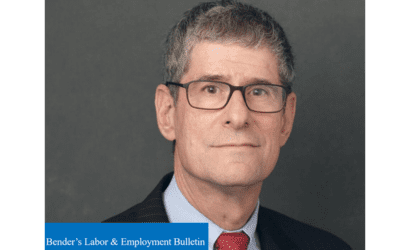What is contra proferentem?
Carlile v. Reliance Standard Life Insurance Co.[1] is a textbook illustration of the doctrine that construes ambiguities in insurance policies in favor of the insured and against the insurer.
In February, the U.S. Court of Appeals for the Tenth Circuit affirmed a ruling by the U.S. District Court for the District of Utah that a policy ambiguity compelled a finding that David Carlile was an active employee at the time he became disabled and therefore qualified to receive disability insurance benefits.
Carlile began working for Lighthouse Resources Inc. in 2012. In November 2014, Carlile was given a 90-day notice of termination, but he continued working through the notice period and the termination was ultimately withdrawn.
However, in 2016, Lighthouse Resources experienced a business downturn, and as a result, Carlile was once again notified in March 2016 that his employment would end in 90 days — i.e., on June 20, 2016.
Carlile was paid in advance for the entire 90-day period. While he was not required to continue working, he did so until June 7, 2016, when he became disabled due to prostate cancer.
Carlile received short-term disability payments from Reliance, but when he was due to transition to long-term disability, Reliance denied his benefit claim after learning that Carlile had been given notice of termination on March 21, 2016, even though Lighthouse Resources advised the insurer that Carlile was working until June 7.
Reliance acknowledged Carlile’s disability, but denied the long-term disability claim on the ground he was no longer an “active” employee after he was given notice of termination.
The court quoted the following provisions from the policy:
“[A]ctively at work” and “active work” mean actually performing on a Full-time basis the material duties pertaining to his/her job in the place where and the manner in which the job is normally performed. This includes approved time off such as vacation, jury duty[,] and funeral leave, but does not include time off as a result of an Injury or Sickness.
“Full-time” means working for [Lighthouse Resources] for a minimum of [thirty] hours during a person’s regular workweek.
Reliance maintained there was no proof Carlile was working at least 30 hours per week after March 2016.
The court explained, though, that the issue came down to the question of “whether a reasonable person in Carlile’s position would have understood that he was ‘an active, Full-time employee’ in June 2016, when the disability arose.”
Although the policy contained definitions of the terms “actively at work” and “active work,” there was no definition of the term “active,” the term used to define coverage eligibility.
The court recited the parties’ contentions and examined various dictionary definitions for the term “active,” before concluding the word meant “something different than the defined terms ‘actively at work’ and ‘active work.'”
The court thus concluded that a reasonable definition of the word “active” was being currently employed even if the employee was “facing an impending termination.” Since there was more than one reasonable definition of the word “active,” the court found the term “ambiguous — an ambiguity that is not resolved by dictionary definitions, precedent or context.”
In the face of such an ambiguity, the court “construe[d] th[e] term [active] in Mr. Carlile’s favor to mean ‘current employee’ rather than endorsing Reliance’s proposed definition of ‘actually working.'”
The court supported its holding by pointing to Tester v. Reliance Standard Life Insurance Co.,[2] a similar ruling by the U.S. Court of Appeals for the Fourth Circuit in a life insurance case involving “similar policy language, the same insurance company, and analogous facts.”
Tester, like Carlile, also involved the question of whether an employee who was on sick leave remained “active”; and the Fourth Circuit likewise deemed the policy term ambiguous since “[t]he policy d[id] not specify under what circumstances the employee must work, how frequently the employee must work, and how long the employee must be out of work before he is no longer considered ‘active.'”[3]
The court found the plaintiff — Douglas Tester, as personal representative of the estate of Ruth Anne Tester — remained active because “[a] reasonable employee would not expect his insurance coverage to terminate if he takes a sick day or if he dies on account of an accident before working [twenty] hours in a particular week” — “such an interpretation … would lead to absurd results outside of the insured’s reasonable expectations.”[4]
The Tenth Circuit acknowledged in Carlile that the facts presented were somewhat different than those in Tester; however, despite the fact that Carlile was not required to do any work during the notice period, his termination was not effective until the end of that period.
Further, Carlile was compensated for the entire period, he had previously been given notice of termination that was subsequently withdrawn, and Lighthouse considered Carlile a full-time employee. From those circumstances, the court applied the same reasoning the Fourth Circuit used in Tester, which was that “a reasonable employee would not expect his insurance coverage to terminate during the notice period based on an understanding that he was no longer an ‘active’ employee.” Hence, the court found that Carlile remained eligible for coverage.
In addition to this ruling, Reliance recently lost on a similar issue in Ministeri v. Reliance Standard Life Insurance Co.[5] which, like Tester, involved continuation of life insurance for an employee who continued working at home for a period of time after experiencing a medical event during a business trip before having to cease working altogether a few weeks later after suffering additional medical complications.
In a February opinion, the U.S. Court of Appeals for the First Circuit relied on Tester and the ruling from the U.S. District Court for the District of Massachusetts in this case in support of its position.
The key determinant to the outcome here was the court’s application of the well-established principle of insurance law known as the rule of contra proferentem, by which a court construes ambiguities in insurance policies in favor of the insured and against the insurer.
Because the policy lacked a definition of the word “active,” the court found the term could have multiple meanings, thus entitling Carlile to ongoing coverage.
Although the opinion did not mention it, the continuation of Carlile’s salary through the notice period likely meant the premiums for his company-sponsored insurance, including his disability insurance, were paid to maintain the Reliance Standard coverage in effect through the entire notice period, which would be yet another argument in the plaintiff’s favor.
What is also significant here, since this case was decided under the Employee Retirement Income Security Act, is the critical importance of the ERISA standard of review.
Had this case been decided under the arbitrary and capricious standard of review rather than the de novo standard utilized by the court, the rule of contra proferentem would likely have been inapplicable.
Since the word “active” has multiple equally plausible meanings, the arbitrary and capricious standard of review would have compelled the court to accept the insurer’s position as falling within the insurer’s discretionary authority to interpret policy terms.
Standards of review matter in ERISA litigation, and the de novo standard of judicial review that applied here was ultimately decisive in Carlile’s victory.
The Carlile ruling also has implications for future cases. Fact patterns similar to what occurred here or in the Tester case cited in this ruling occur with regularity.
Most employers want to look out for their employees and make sure their benefits remain in place to protect them while they continue to be employed.
An unfavorable ruling in Carlile would have reinforced the cynical maxim that no good deed goes unpunished.
To avoid such a perverse result, continuation of disability or life insurance benefits while a worker remains employed is salutary, especially since the insurance company is usually receiving ongoing premium payments.
The other positive takeaway from this ruling is that the principle of contra proferentem broadens insurance coverage.
Presumably, a sophisticated insurance company has the ability and thus knows how to write an unambiguous policy to state exactly what it intends.
The failure to do so, and the existence of a default rule that construes policy ambiguities in favor of the insured, prevents insurers from later adopting a self-serving interpretation of their policies in a manner that avoids coverage.
It also creates an incentive for insurers to clearly say what they mean and mean what they say.
Had the policy at issue in Carlile been written more clearly, the defendant could have avoided costly litigation and an expensive adverse determination from the Tenth Circuit.
Mark DeBofsky is a shareholder at DeBofsky Law.
This article was first published by Law360 on March 15, 2021
[1] 2021 U.S. App. LEXIS 5013, 2021 WL 671582 (10th Cir. February 22, 2021).
[2] 228 F.3d 372 (4th Cir. 2000).
[3] Id. at 377
[4] Id. at 376–77.
[5] 2021 U.S. Dist. LEXIS 25050, 2021 WL 495151 (D. Mass. February 10, 2021).







